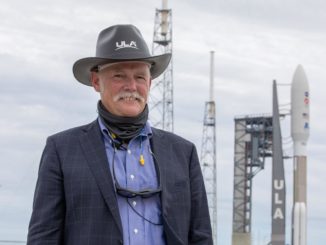EDITOR’S NOTE: Updated Sept. 11 with pad arrival.

The towering mobile platform for NASA’s Space Launch System emerged from the Vehicle Assembly Building at the Kennedy Space Center in Florida Tuesday morning, returning to a seaside launch complex to complete tests interrupted by Hurricane Dorian last week.
The 380-foot-tall (115-meter) structure’s validation and verification testing was about 80 percent complete when teams returned the SLS Mobile Launcher to the cavernous Vehicle Assembly Building on Aug. 30 for safekeeping as Hurricane Dorian threatened Florida’s Space Coast.
The launch tower is rated to withstand 110 mph winds, according to NASA, while the VAB can take 125 mph winds.
The SLS mobile launch pad is made of a square base structure and a tower containing retractable umbilical arms, propellant plumbing, elevators, toilets and other systems. The Mobile Launcher completed a nine-month test campaign inside the VAB’s High Bay 3 earlier this year, then rolled out June 28 for checkouts at pad 39B before SLS rocket components begin arriving at Kennedy for stacking.
The 10.5-million-pound Mobile Launcher completed the 4.2-mile (6.8-kilometer) trip back to pad 39B early Wednesday on top of an Apollo-era diesel-powered crawler-transporter. The platform paused at the main gate of pad 39B overnight before resuming the trip up the ramp Wednesday morning.
With the tower now back at pad 39B, engineers will complete testing and checkouts in the coming weeks in preparation for the Artemis 1 mission, the first SLS test launch scheduled for 2021.
“Before the storm, 80 percent of the validation and verification testing with the pad and launcher were complete, and EGS (Exploration Ground Systems) does not expect any significant impacts to their upcoming test schedules due to the hurricane,” NASA said in a statement.
The mobile launch tower’s verification testing includes swing arm retractions to mimic their function during a launch countdown, and pumping cryogenic liquid hydrogen and liquid oxygen propellants through the structure’s plumbing for the first time.
In recent weeks, teams conducted water flow tests on the Mobile Launcher at pad 39B to check the performance of the sound suppression and ignition overpressure systems, which reduce the heat and acoustic energy generated as the SLS main engines and solid rocket boosters fire up at liftoff.
Once the testing is complete, the tower will return to the VAB, where cranes will begin stacking components of the Space Launch System once the flight hardware is ready.
Email the author.
Follow Stephen Clark on Twitter: @StephenClark1.



